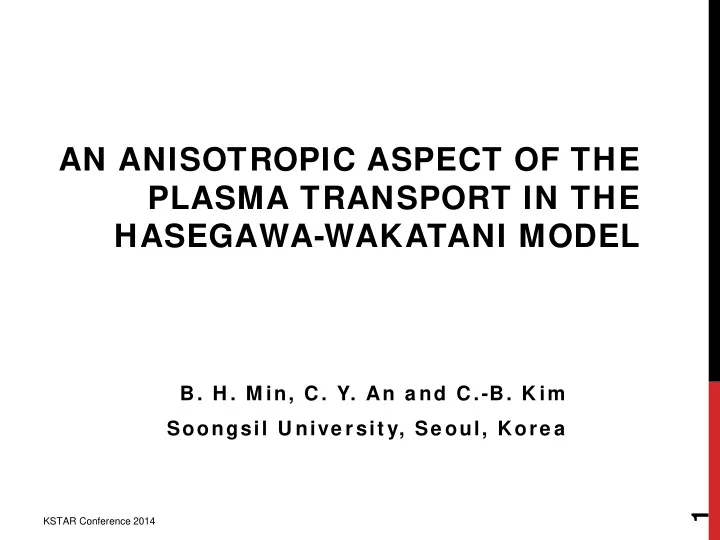

AN ANISOTROPIC ASPECT OF THE PLASMA TRANSPORT IN THE HASEGAWA-WAKATANI MODEL B. H . M in, C. Y. An a nd C.-B. K im Soongsil U nive rsit y, Se oul, Kore a 1 KSTAR Conference 2014
ABSTRACT Motivated by recent works on the advection excited in the noise- driven Hasegawa-Mima model, Hasegawa-Wakatani equations are studied as a self-consistent extension. Nonlinear energy fluxes due to the E × B convective derivatives of both the vorticity and the plasma density are divided into two parts. One part, which is almost isotropic, is well known to engage in the transfer of the energies from the energy-producing scale where the phase mismatch between the density and the electric potential is large. The other part is found to be anisotropic and approximately advective in the Fourier space, with the directions of the advection of the kinetic and the particle energies being opposite. The advecting velocity in the Fourier space is derived after the comparison is made to the gradients of the energies. Implications of the findings to the transport of the fusion plasmas will be presented. 2 KSTAR Conference 2014
CONTENTS 1. Hasegawa-Wakatani equations 2. Conservation laws Global and local 3. Simulation results Local energy balance Density-potential coherence Anisotropic part of nonlinear fluxes adiabaticity = 1.0, 0.1, 0.01 4. Conclusions 3 KSTAR Conference 2014
HASEGAWA-WAKATANI EQUATIONS 𝜖 � − 𝑜 𝜖𝑢 𝜕 � + 𝑤 ⃗ ∙ 𝛼 ⊥ 𝜕 � = 𝛽 𝜚 � + 𝐸 𝜚 energy production term from 𝑜 0 gradient � 𝜖 𝜖𝜚 dissipative term � − 𝑜 𝜖𝑢 𝑜 � + 𝑤 ⃗ ∙ 𝛼 ⊥ 𝑜 � + 𝜖𝜖 = 𝛽 ( 𝜚 � ) + 𝐸 𝑜 EXB convecive term resistive coupling term comes from electron response 𝜖 2 𝑈 Adiabaticity parameter 𝛽 = − 𝜖𝑨 2 𝑓 2 𝑜 0 𝜃 ∥ 𝜕 𝑑𝑑 � ExB velocity 𝑤 ⃗ = 𝑨̂ × 𝛼 ⊥ 𝜚 � 2 𝜚 Vorticity 𝜕 � = 𝛼 ⊥ Units: time 𝑀 𝑜 / 𝑑 𝑡 , space 𝜍 𝑡 , potential 𝑈𝜍 𝑡 / 𝑓𝑀 𝑜 , density 𝑜 0 𝜍 𝑡 / 𝑀 𝑜 4 𝜕 4 𝑜 𝐸 𝜚 = 𝜉 𝜚 𝛼 ⊥ � , 𝐸 𝑜 = 𝜉 𝑜 𝛼 ⊥ � 4 KSTAR Conference 2014
CONSERVATION LAWS Energy and enstrophy � 2 + | 𝛼 ⊥ 𝜚 1 � | 2 ) 2 ∫ 𝑒 2 𝑦 ( 𝑜 𝐹 = 1 2 ∫ 𝑒 2 𝑦 ( 𝑜 � ) 2 𝑉 = � − 𝜕 Global conservation � 𝜖𝐹 𝜖𝜚 � ) 2 − ∫ 𝑒 2 𝑦 ( 𝑜 �𝐸 𝜚 ) 𝜖𝑢 = ∫ 𝑒 2 𝑦 𝑜 𝜖𝜖 ) − α∫ 𝑒 2 𝑦 ( 𝑜 � ( − � − 𝜚 �𝐸 𝑜 − 𝜚 � 𝜖𝑉 𝜖𝜚 𝜖𝑢 = ∫ 𝑒 2 𝑦 𝑜 𝜖𝜖 ) − ∫ 𝑒 2 𝑦 ( 𝑜 � ( − � − 𝜕 � )( 𝐸 𝑜 − 𝐸 𝜚 ) 5 KSTAR Conference 2014
Local conservation law Energy density 𝜖 1 � | 2 + 𝑜 � 𝑤 � 2 ) − 𝜚 2 (| 𝛼 ⊥ 𝜚 ⃗ ∙ 𝛼 ⊥ 𝜕 � + 𝑜 � 𝑤 ⃗ ∙ 𝛼 ⊥ 𝑜 � 𝜖𝑢 � − 𝜖𝜚 � ) 2 + ( 𝑜 �𝐸 𝜚 ) = 𝑜 � − α ( 𝑜 � − 𝜚 �𝐸 𝑜 + 𝜚 𝜖𝜖 Enstrophy density � � ) 2 + 𝑤 � ) 2 = ( 𝑜 𝜖 1 1 𝜖𝜚 � )( 𝐸 𝑜 − 𝐸 𝜚 ) 2 ( 𝑜 � − 𝜕 ⃗ ∙ 𝛼 ⊥ 2 ( 𝑜 � − 𝜕 � − 𝜕 � ) − 𝜖𝜖 + ( 𝑜 � − 𝜚 𝜖𝑢 6 KSTAR Conference 2014
Local energy balance Adiabaticity parameter 𝜷 = 𝟐 . 𝟏 energy transfer energy production resistive loss dissipative loss 7 KSTAR Conference 2014
Density-potential coherence Real Imaginary 𝒍 𝒛 ∑ ( 𝐒𝐒𝐒𝐒 𝐪𝐒𝐪𝐪 ) • 𝒍 𝒚 𝟓 ∑ ( 𝐉𝐉𝐒𝐉 . 𝐪𝐒𝐪𝐪 ) • 𝒍 𝒚 8 KSTAR Conference 2014
Anisotropic flux Adiabaticity parameter 𝜷 = 𝟐 . 𝟏 Sum over 𝒍 𝒛 Fitting with advective flux sum over 𝒍 𝒚 • −𝟏 . 𝟐𝟒 • 𝒍 𝟑 −𝟏 . 𝟑𝟑 • 𝟐+𝒍 𝟑 9 KSTAR Conference 2014
Anisotropic flux Adiabaticity parameter 𝜷 = 0.01 Adiabaticity parameter 𝜷 = 0.1 sum over 𝒍 𝒚 sum over 𝒍 𝒚 • • −𝟏 . 𝟐 −𝟏 . 𝟐𝟑 • • 10 KSTAR Conference 2014
Anisotropic flux Adiabaticity parameter 𝜷 = 𝟐 . 𝟏 Sum over 𝒍 𝒛 Fitting with advective flux sum over 𝒍 𝒚 • 0. 𝟑 • 0. 𝟑 • 11 KSTAR Conference 2014
Anisotropic flux Adiabaticity parameter 𝜷 = 0.01 Adiabaticity parameter 𝜷 = 0.1 sum over 𝒍 𝒚 sum over 𝒍 𝒚 • • 0. 𝟖 0. 𝟑𝟑 • • 0. 𝟑 0. 𝟓𝟑 • • 12 KSTAR Conference 2014
CONCLUSIONS Nonlinear energy fluxes excluding the parts that are responsible for the energy transfer are found to be: anisotropic; advective along the direction of 𝒘 𝒆𝒆 ; kinetic energy being advected; � 𝑙 | 2 ; particle energy advection being determined by | 𝜚 Work is still progressing to extend to larger values of α . 13 KSTAR Conference 2014
Recommend
More recommend